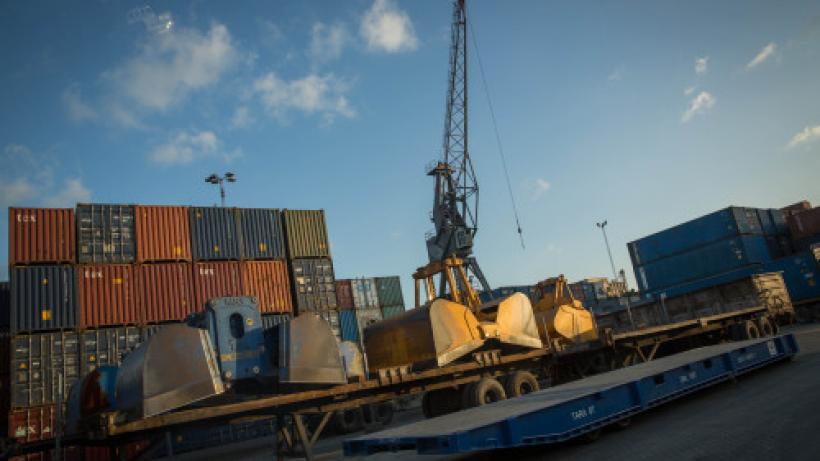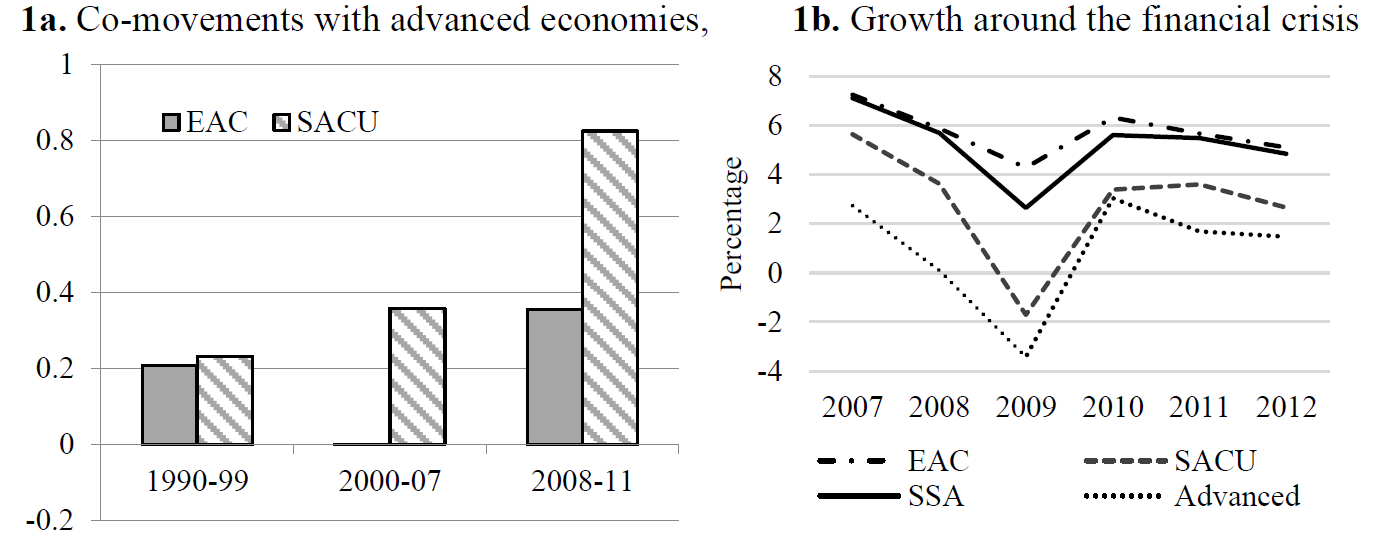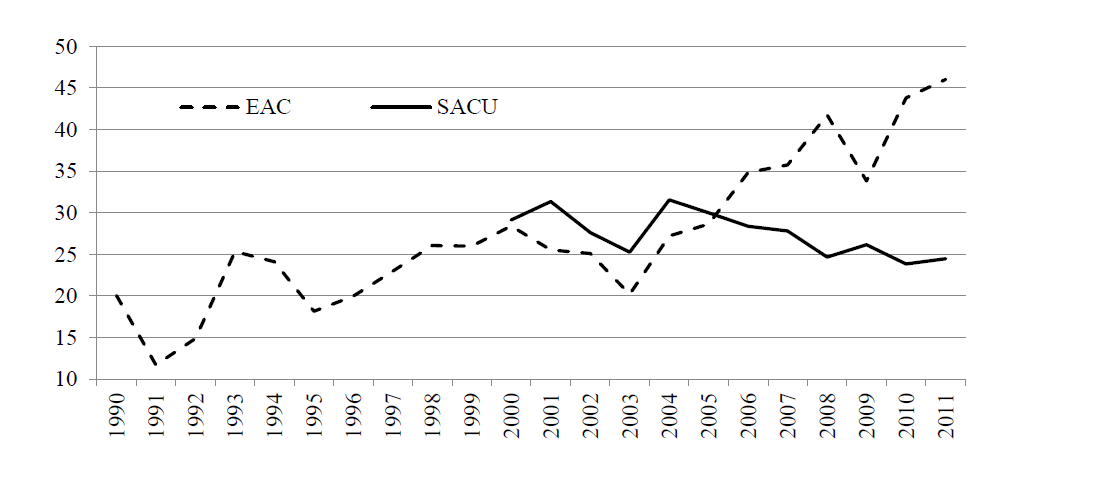
Can intra-regional trade act as a global shock absorber in Africa?
Trade is a fundamental driver of economic growth and productive employment. Identifying effective policies that can enhance regional economic integration is an essential component of the new Sustainable Development Goals. In this fourth piece for the IGC, South Asia @ LSE and Africa @ LSE cross-blog series, Zuzana Brixiová, Qingwei Meng, and Professor Mthuli Ncube analyse the role of regional integration in shaping the resilience of African economies to external shocks.
The recent global financial crisis and subsequent slow global recovery have brought about a renewed emphasis on Africa’s vulnerability to external shocks. Africa has recovered quickly from the global crisis and has continued to be one of the fastest growing regions in the world. However, African economies and regional economic communities (RECs) exhibited varied degrees of co-movements with the advanced economies. Increased output co-movements occur when economies move in closer lockstep, as demonstrated by higher correlations of their real GDP growth. The differences among Africa’s RECs in output co-movements with advanced economies, measured by growth correlations, were particularly pronounced between the East African Community (EAC) and the Southern African Customs Union (SACU). In our recent working paper, we examined the role of intra-regional trade in explaining such differences.
Regional trade and resilience to external shocks
The relationship between the intensity of trade integration and a region’s resilience to external output shocks is ambiguous. One avenue to understanding the relationship may be analysing the balance between inter and intra-industry trade links within the region. On the one hand, increased inter-industry specialisation among integrated economies can deepen differences in production and shocks. On the other hand, even diversified economies with high share of intra-industry trade tend to experience similar shocks. This may be explained partly because outputs in sectors with high intra-industry trading tend to be more synchronised (see Misztal, 2013, for findings on emerging Europe and Rana, 2007, for Asia).
Output co-movements
The more synchronized the real GDP growth between the advanced economies and Africa’s RECs before a global shock sets in, the more vulnerable Africa’s RECs are to such shocks directly or to spill-overs from advanced economies. Figure 1a illustrates that in the 1990s output co-movements, measured by growth correlations, had been subdued in both the EAC and the SACU. During the early 2000s, the SACU and the EAC took divergent paths: correlations of growth rates with developed countries increased for the SACU, but fell close to none for the EAC. As in other emerging and frontier markets (IMF, 2013), these correlations rose markedly during the financial crisis for both regions, and reached particularly high levels in the SACU (Figures 1a and 1b).
Differences between the EAC and the SACU emerged also within the respective regional economic communities. In the EAC, with the exception of Burundi, growth rates of the individual EAC members (e.g., Kenya, Rwanda, Tanzania, and Uganda) were correlated with growth of the EAC and also that of Sub-Saharan Africa. In contrast, the co-movements of growth of the small SACU members (e.g., Botswana, Lesotho, Namibia, and Swaziland) with the SACU region as a whole were weaker (please see the working paper).
Figure 1. Real GDP growth co of Africa’s RECs with advanced economies

Source: Brixiová, Meng and Ncube (2015).
Links between trade and output co-movements
We looked into the role of trade linkages in transmitting output shocks from (i) the advanced economies into regional communities and (ii) from the advanced economies and the regional communities into REC’s members. Special attention was paid to intra-regional and intra-industry trade as key factors of regional resilience to external output shocks.
- Intra-regional trade – Africa’s regional trade remains low compared to other world regions (the average share of intra-African exports in total exports during 2000-2012 was only 11 percent, less than the 25 percent average in Latin America and 51 percent average in Asia). Differences also exist among African sub-regions, with the intra-regional trade accounting for the largest –increasing – share of total trade in the EAC. The available data (from 2001 on) indicates that the trade integration in the SACU is low (Table 1).
- Intra-industry trade – The intensity of intra-industry trade flows, measured by Grubel-Lloyd index, showed that such trade had remained relatively low in both RECs from early until mid-2000s, with the higher –rapidly rising– intra-industry trade intensity in the EAC since then (Figure 2).
Table 1. Shares of Intra-regional and Intra-African Trade (% of total exports)

Source: Brixiová, Meng and Ncube (2015).
In sum, trade in the EAC is more integrated than in the SACU according to both measures. Empirical results suggest that more intensive intra-regional and intra-industry trade ties have likely contributed to the EAC’s resilience to output shocks during the global financial crisis. Specifically, the EAC countries were relatively shielded from a fall in import demand in advanced economies. Experiences of small SACU countries, such as the Swaziland’s fiscal crisis in 2011- 2012 triggered by a fall in SACU receipts, showed once again the vulnerability to shocks strongly driven by excessive concentration, in either products or markets.
Figure 2. Grubel-Lloyd Intra-Industry Trade Index, 1990-2011

Source: Brixiová, Meng and Ncube (2015).
Where does this leave us?
The policy implications from our analysis point to the role of regional integration in building resilience of African countries against external shocks. However, the beneficial impact of regional integration is not a given. The recent examples of the small SACU members show that they would also benefit from export diversification into fast growing emerging markets outside the REC in order to reduce exposure to advanced economies and slow-growing South Africa.
Several important issues remain for future research. First is gaining a better understanding of the relationship between regional integration and intra-regional trade and how to strengthen multilateral trade ties. Our results should not be interpreted as support for regional integration via preferential regional trade agreements at the expense of multilateral trade. Second, we have focused on the transmission of shocks from the advanced economies to Africa, leaving the impact of shocks in emerging markets on Africa to further investigation. Finally, future research could examine channels through which intra-regional trade facilitates diversification and integration of African RECs into global value chains.
Further references
Brixiová, Z., Meng, Q. and Ncube, M. (2015), ‘Can Intra-Regional Trade Act as a Global Shock Absorber in Africa?’, IZA Discussion Paper No. 9205.
International Monetary Fund (2013), ‘Dancing Together? Spillovers, Common Shocks, and the Role of Financial and Trade Linkages’, in World Economic Outlook: Transition and Tensions, October 2013, IMF: Washington, DC.
Misztal, P. (2013), ‘International Trade and Business Cycle Synchronization in Poland, the European Union, and the Euro Zone’, Contemporary Economics, Vol. 7(3), 65 – 78.
Rana, P. (2007), ‘Trade Intensity and Business Cycle Synchronization: The Case of East Asia’, Asian Development Bank Working Paper Series on Regional Economic Integration No. 10.
This blog reflects the views of the authors, and not the IGC

